Analysis of Job Satisfaction and Motivation on Employee Performance
VerifiedAdded on 2020/03/13
|8
|1969
|283
Report
AI Summary
This report delves into the effects of job satisfaction and motivation on employee performance, focusing on a study conducted at Credit Suisse. The methodology employed is qualitative, emphasizing in-depth understanding through interviews, observations, and questionnaires, with a non-probability purposive sampling technique. The report explores the strengths and weaknesses of qualitative research, comparing it to alternative methods. Data collection involves primary and secondary sources, including Credit Suisse staff and published materials. Ethical considerations, such as confidentiality and informed consent, are addressed. The research aims to provide insights into employee behavior, satisfaction, and turnover, ultimately helping Credit Suisse improve employee motivation and performance. The report also includes a detailed discussion on sampling techniques and data collection tools, including a review of existing data, interviewing, observations, and administration of a written questionnaire. The research population is the entire Credit Suisse members in Australia. The report also addresses ethical issues, ensuring confidentiality and informed consent.
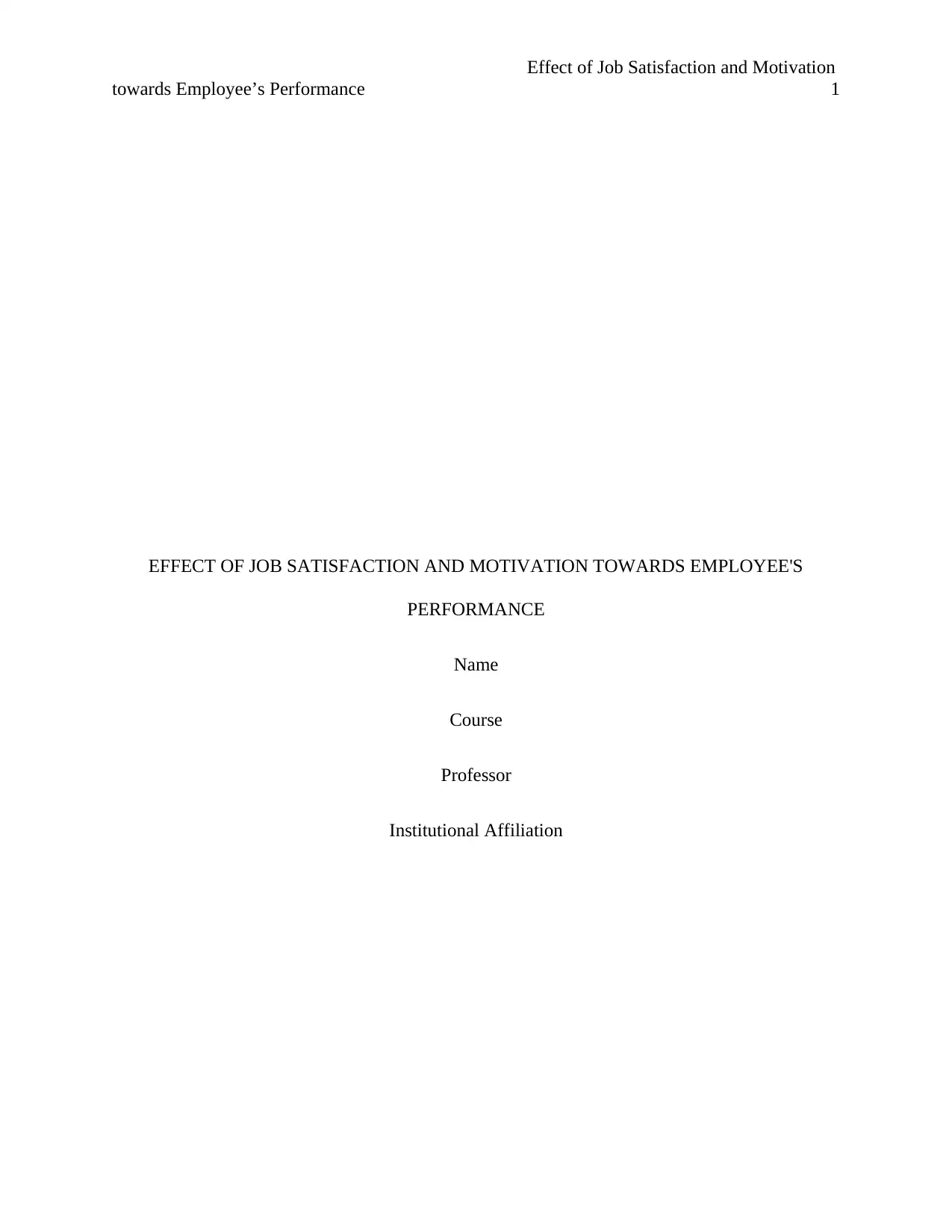
Effect of Job Satisfaction and Motivation
towards Employee’s Performance 1
EFFECT OF JOB SATISFACTION AND MOTIVATION TOWARDS EMPLOYEE'S
PERFORMANCE
Name
Course
Professor
Institutional Affiliation
towards Employee’s Performance 1
EFFECT OF JOB SATISFACTION AND MOTIVATION TOWARDS EMPLOYEE'S
PERFORMANCE
Name
Course
Professor
Institutional Affiliation
Paraphrase This Document
Need a fresh take? Get an instant paraphrase of this document with our AI Paraphraser
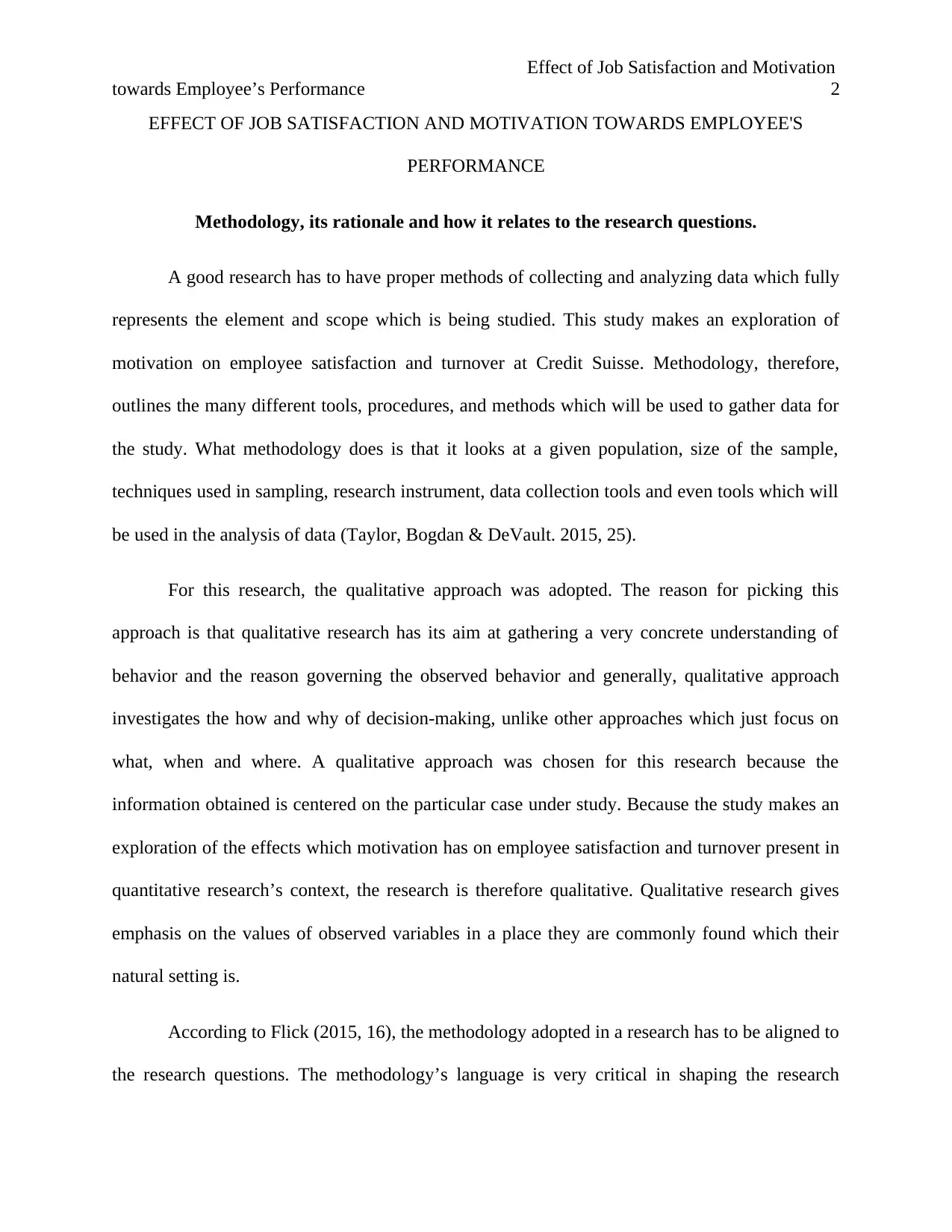
Effect of Job Satisfaction and Motivation
towards Employee’s Performance 2
EFFECT OF JOB SATISFACTION AND MOTIVATION TOWARDS EMPLOYEE'S
PERFORMANCE
Methodology, its rationale and how it relates to the research questions.
A good research has to have proper methods of collecting and analyzing data which fully
represents the element and scope which is being studied. This study makes an exploration of
motivation on employee satisfaction and turnover at Credit Suisse. Methodology, therefore,
outlines the many different tools, procedures, and methods which will be used to gather data for
the study. What methodology does is that it looks at a given population, size of the sample,
techniques used in sampling, research instrument, data collection tools and even tools which will
be used in the analysis of data (Taylor, Bogdan & DeVault. 2015, 25).
For this research, the qualitative approach was adopted. The reason for picking this
approach is that qualitative research has its aim at gathering a very concrete understanding of
behavior and the reason governing the observed behavior and generally, qualitative approach
investigates the how and why of decision-making, unlike other approaches which just focus on
what, when and where. A qualitative approach was chosen for this research because the
information obtained is centered on the particular case under study. Because the study makes an
exploration of the effects which motivation has on employee satisfaction and turnover present in
quantitative research’s context, the research is therefore qualitative. Qualitative research gives
emphasis on the values of observed variables in a place they are commonly found which their
natural setting is.
According to Flick (2015, 16), the methodology adopted in a research has to be aligned to
the research questions. The methodology’s language is very critical in shaping the research
towards Employee’s Performance 2
EFFECT OF JOB SATISFACTION AND MOTIVATION TOWARDS EMPLOYEE'S
PERFORMANCE
Methodology, its rationale and how it relates to the research questions.
A good research has to have proper methods of collecting and analyzing data which fully
represents the element and scope which is being studied. This study makes an exploration of
motivation on employee satisfaction and turnover at Credit Suisse. Methodology, therefore,
outlines the many different tools, procedures, and methods which will be used to gather data for
the study. What methodology does is that it looks at a given population, size of the sample,
techniques used in sampling, research instrument, data collection tools and even tools which will
be used in the analysis of data (Taylor, Bogdan & DeVault. 2015, 25).
For this research, the qualitative approach was adopted. The reason for picking this
approach is that qualitative research has its aim at gathering a very concrete understanding of
behavior and the reason governing the observed behavior and generally, qualitative approach
investigates the how and why of decision-making, unlike other approaches which just focus on
what, when and where. A qualitative approach was chosen for this research because the
information obtained is centered on the particular case under study. Because the study makes an
exploration of the effects which motivation has on employee satisfaction and turnover present in
quantitative research’s context, the research is therefore qualitative. Qualitative research gives
emphasis on the values of observed variables in a place they are commonly found which their
natural setting is.
According to Flick (2015, 16), the methodology adopted in a research has to be aligned to
the research questions. The methodology’s language is very critical in shaping the research
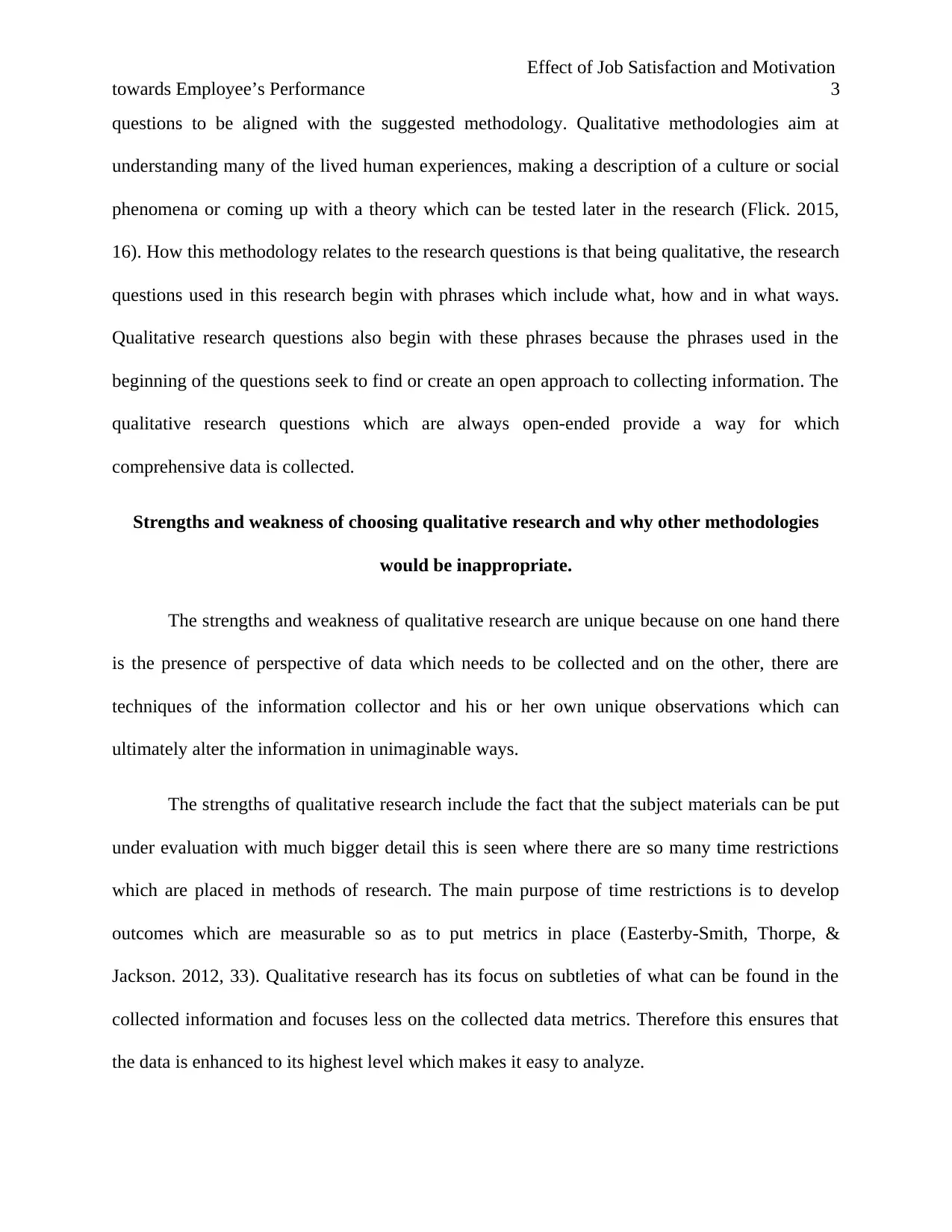
Effect of Job Satisfaction and Motivation
towards Employee’s Performance 3
questions to be aligned with the suggested methodology. Qualitative methodologies aim at
understanding many of the lived human experiences, making a description of a culture or social
phenomena or coming up with a theory which can be tested later in the research (Flick. 2015,
16). How this methodology relates to the research questions is that being qualitative, the research
questions used in this research begin with phrases which include what, how and in what ways.
Qualitative research questions also begin with these phrases because the phrases used in the
beginning of the questions seek to find or create an open approach to collecting information. The
qualitative research questions which are always open-ended provide a way for which
comprehensive data is collected.
Strengths and weakness of choosing qualitative research and why other methodologies
would be inappropriate.
The strengths and weakness of qualitative research are unique because on one hand there
is the presence of perspective of data which needs to be collected and on the other, there are
techniques of the information collector and his or her own unique observations which can
ultimately alter the information in unimaginable ways.
The strengths of qualitative research include the fact that the subject materials can be put
under evaluation with much bigger detail this is seen where there are so many time restrictions
which are placed in methods of research. The main purpose of time restrictions is to develop
outcomes which are measurable so as to put metrics in place (Easterby-Smith, Thorpe, &
Jackson. 2012, 33). Qualitative research has its focus on subtleties of what can be found in the
collected information and focuses less on the collected data metrics. Therefore this ensures that
the data is enhanced to its highest level which makes it easy to analyze.
towards Employee’s Performance 3
questions to be aligned with the suggested methodology. Qualitative methodologies aim at
understanding many of the lived human experiences, making a description of a culture or social
phenomena or coming up with a theory which can be tested later in the research (Flick. 2015,
16). How this methodology relates to the research questions is that being qualitative, the research
questions used in this research begin with phrases which include what, how and in what ways.
Qualitative research questions also begin with these phrases because the phrases used in the
beginning of the questions seek to find or create an open approach to collecting information. The
qualitative research questions which are always open-ended provide a way for which
comprehensive data is collected.
Strengths and weakness of choosing qualitative research and why other methodologies
would be inappropriate.
The strengths and weakness of qualitative research are unique because on one hand there
is the presence of perspective of data which needs to be collected and on the other, there are
techniques of the information collector and his or her own unique observations which can
ultimately alter the information in unimaginable ways.
The strengths of qualitative research include the fact that the subject materials can be put
under evaluation with much bigger detail this is seen where there are so many time restrictions
which are placed in methods of research. The main purpose of time restrictions is to develop
outcomes which are measurable so as to put metrics in place (Easterby-Smith, Thorpe, &
Jackson. 2012, 33). Qualitative research has its focus on subtleties of what can be found in the
collected information and focuses less on the collected data metrics. Therefore this ensures that
the data is enhanced to its highest level which makes it easy to analyze.
⊘ This is a preview!⊘
Do you want full access?
Subscribe today to unlock all pages.

Trusted by 1+ million students worldwide
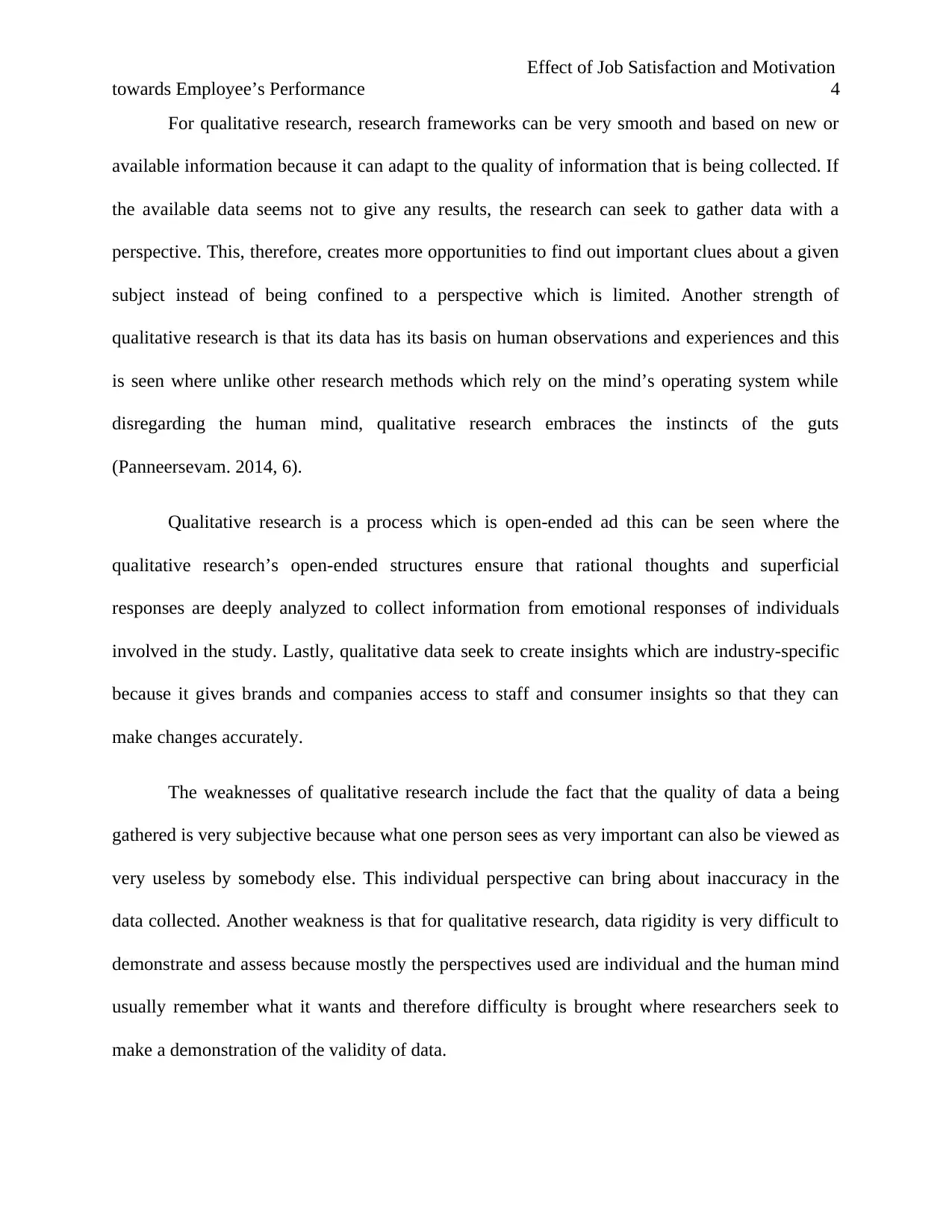
Effect of Job Satisfaction and Motivation
towards Employee’s Performance 4
For qualitative research, research frameworks can be very smooth and based on new or
available information because it can adapt to the quality of information that is being collected. If
the available data seems not to give any results, the research can seek to gather data with a
perspective. This, therefore, creates more opportunities to find out important clues about a given
subject instead of being confined to a perspective which is limited. Another strength of
qualitative research is that its data has its basis on human observations and experiences and this
is seen where unlike other research methods which rely on the mind’s operating system while
disregarding the human mind, qualitative research embraces the instincts of the guts
(Panneersevam. 2014, 6).
Qualitative research is a process which is open-ended ad this can be seen where the
qualitative research’s open-ended structures ensure that rational thoughts and superficial
responses are deeply analyzed to collect information from emotional responses of individuals
involved in the study. Lastly, qualitative data seek to create insights which are industry-specific
because it gives brands and companies access to staff and consumer insights so that they can
make changes accurately.
The weaknesses of qualitative research include the fact that the quality of data a being
gathered is very subjective because what one person sees as very important can also be viewed as
very useless by somebody else. This individual perspective can bring about inaccuracy in the
data collected. Another weakness is that for qualitative research, data rigidity is very difficult to
demonstrate and assess because mostly the perspectives used are individual and the human mind
usually remember what it wants and therefore difficulty is brought where researchers seek to
make a demonstration of the validity of data.
towards Employee’s Performance 4
For qualitative research, research frameworks can be very smooth and based on new or
available information because it can adapt to the quality of information that is being collected. If
the available data seems not to give any results, the research can seek to gather data with a
perspective. This, therefore, creates more opportunities to find out important clues about a given
subject instead of being confined to a perspective which is limited. Another strength of
qualitative research is that its data has its basis on human observations and experiences and this
is seen where unlike other research methods which rely on the mind’s operating system while
disregarding the human mind, qualitative research embraces the instincts of the guts
(Panneersevam. 2014, 6).
Qualitative research is a process which is open-ended ad this can be seen where the
qualitative research’s open-ended structures ensure that rational thoughts and superficial
responses are deeply analyzed to collect information from emotional responses of individuals
involved in the study. Lastly, qualitative data seek to create insights which are industry-specific
because it gives brands and companies access to staff and consumer insights so that they can
make changes accurately.
The weaknesses of qualitative research include the fact that the quality of data a being
gathered is very subjective because what one person sees as very important can also be viewed as
very useless by somebody else. This individual perspective can bring about inaccuracy in the
data collected. Another weakness is that for qualitative research, data rigidity is very difficult to
demonstrate and assess because mostly the perspectives used are individual and the human mind
usually remember what it wants and therefore difficulty is brought where researchers seek to
make a demonstration of the validity of data.
Paraphrase This Document
Need a fresh take? Get an instant paraphrase of this document with our AI Paraphraser
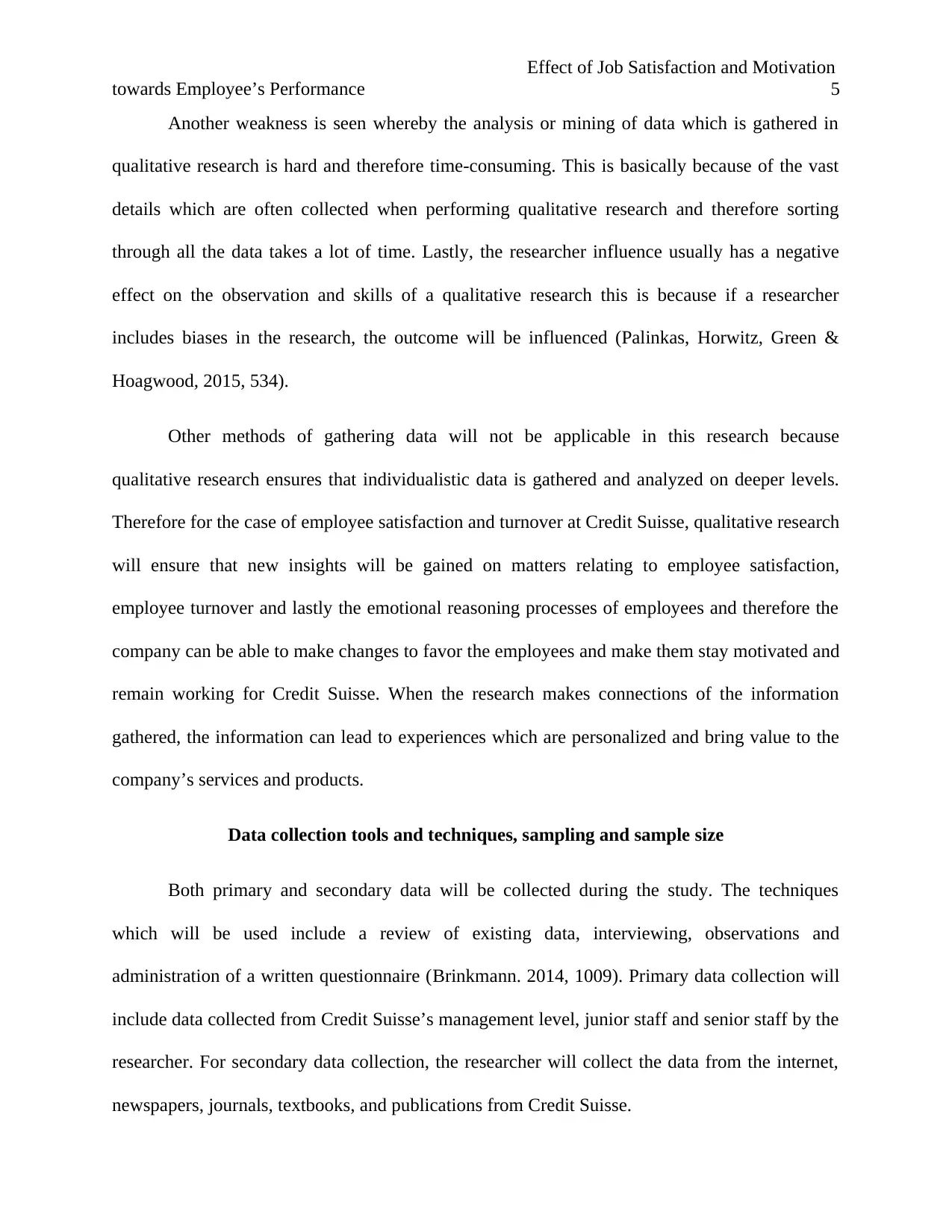
Effect of Job Satisfaction and Motivation
towards Employee’s Performance 5
Another weakness is seen whereby the analysis or mining of data which is gathered in
qualitative research is hard and therefore time-consuming. This is basically because of the vast
details which are often collected when performing qualitative research and therefore sorting
through all the data takes a lot of time. Lastly, the researcher influence usually has a negative
effect on the observation and skills of a qualitative research this is because if a researcher
includes biases in the research, the outcome will be influenced (Palinkas, Horwitz, Green &
Hoagwood, 2015, 534).
Other methods of gathering data will not be applicable in this research because
qualitative research ensures that individualistic data is gathered and analyzed on deeper levels.
Therefore for the case of employee satisfaction and turnover at Credit Suisse, qualitative research
will ensure that new insights will be gained on matters relating to employee satisfaction,
employee turnover and lastly the emotional reasoning processes of employees and therefore the
company can be able to make changes to favor the employees and make them stay motivated and
remain working for Credit Suisse. When the research makes connections of the information
gathered, the information can lead to experiences which are personalized and bring value to the
company’s services and products.
Data collection tools and techniques, sampling and sample size
Both primary and secondary data will be collected during the study. The techniques
which will be used include a review of existing data, interviewing, observations and
administration of a written questionnaire (Brinkmann. 2014, 1009). Primary data collection will
include data collected from Credit Suisse’s management level, junior staff and senior staff by the
researcher. For secondary data collection, the researcher will collect the data from the internet,
newspapers, journals, textbooks, and publications from Credit Suisse.
towards Employee’s Performance 5
Another weakness is seen whereby the analysis or mining of data which is gathered in
qualitative research is hard and therefore time-consuming. This is basically because of the vast
details which are often collected when performing qualitative research and therefore sorting
through all the data takes a lot of time. Lastly, the researcher influence usually has a negative
effect on the observation and skills of a qualitative research this is because if a researcher
includes biases in the research, the outcome will be influenced (Palinkas, Horwitz, Green &
Hoagwood, 2015, 534).
Other methods of gathering data will not be applicable in this research because
qualitative research ensures that individualistic data is gathered and analyzed on deeper levels.
Therefore for the case of employee satisfaction and turnover at Credit Suisse, qualitative research
will ensure that new insights will be gained on matters relating to employee satisfaction,
employee turnover and lastly the emotional reasoning processes of employees and therefore the
company can be able to make changes to favor the employees and make them stay motivated and
remain working for Credit Suisse. When the research makes connections of the information
gathered, the information can lead to experiences which are personalized and bring value to the
company’s services and products.
Data collection tools and techniques, sampling and sample size
Both primary and secondary data will be collected during the study. The techniques
which will be used include a review of existing data, interviewing, observations and
administration of a written questionnaire (Brinkmann. 2014, 1009). Primary data collection will
include data collected from Credit Suisse’s management level, junior staff and senior staff by the
researcher. For secondary data collection, the researcher will collect the data from the internet,
newspapers, journals, textbooks, and publications from Credit Suisse.
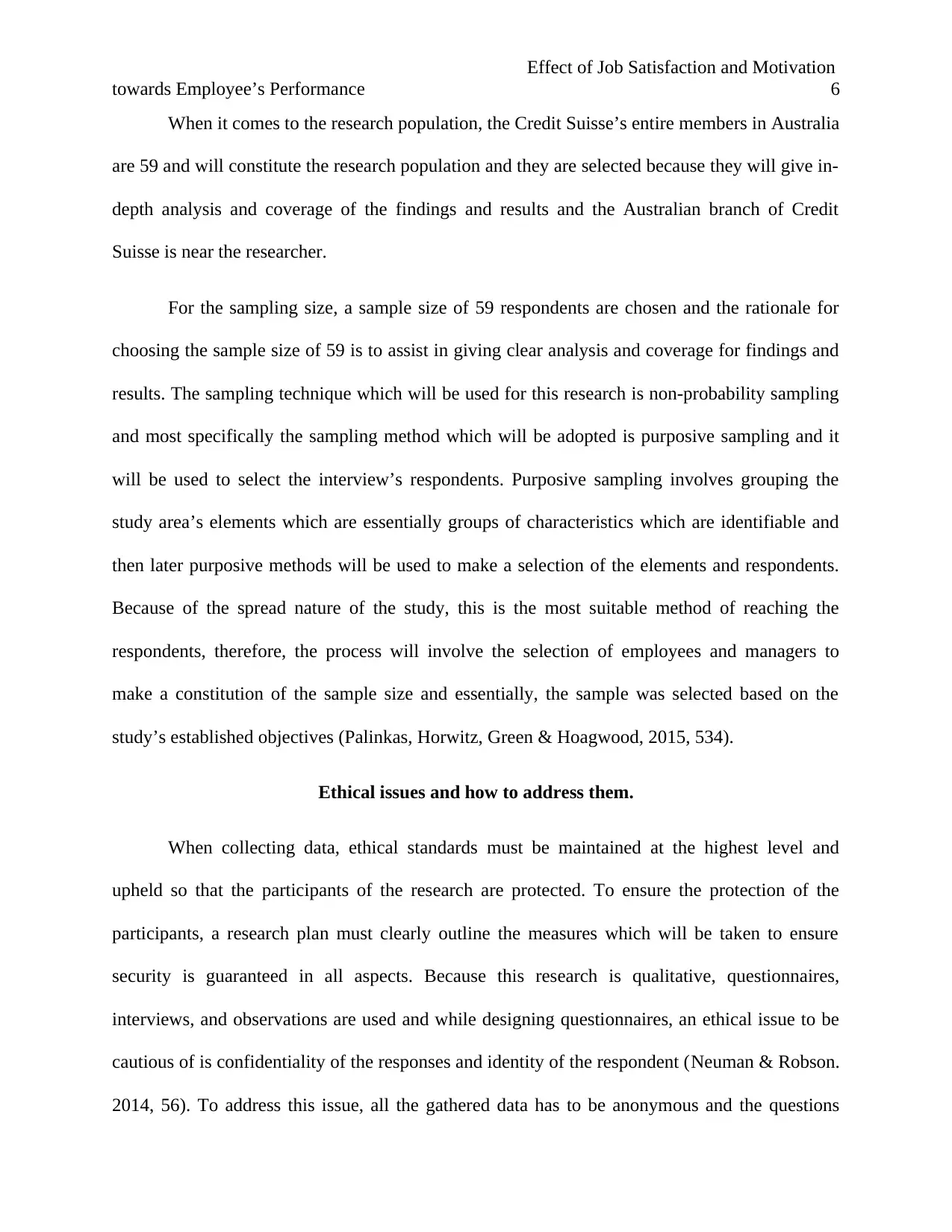
Effect of Job Satisfaction and Motivation
towards Employee’s Performance 6
When it comes to the research population, the Credit Suisse’s entire members in Australia
are 59 and will constitute the research population and they are selected because they will give in-
depth analysis and coverage of the findings and results and the Australian branch of Credit
Suisse is near the researcher.
For the sampling size, a sample size of 59 respondents are chosen and the rationale for
choosing the sample size of 59 is to assist in giving clear analysis and coverage for findings and
results. The sampling technique which will be used for this research is non-probability sampling
and most specifically the sampling method which will be adopted is purposive sampling and it
will be used to select the interview’s respondents. Purposive sampling involves grouping the
study area’s elements which are essentially groups of characteristics which are identifiable and
then later purposive methods will be used to make a selection of the elements and respondents.
Because of the spread nature of the study, this is the most suitable method of reaching the
respondents, therefore, the process will involve the selection of employees and managers to
make a constitution of the sample size and essentially, the sample was selected based on the
study’s established objectives (Palinkas, Horwitz, Green & Hoagwood, 2015, 534).
Ethical issues and how to address them.
When collecting data, ethical standards must be maintained at the highest level and
upheld so that the participants of the research are protected. To ensure the protection of the
participants, a research plan must clearly outline the measures which will be taken to ensure
security is guaranteed in all aspects. Because this research is qualitative, questionnaires,
interviews, and observations are used and while designing questionnaires, an ethical issue to be
cautious of is confidentiality of the responses and identity of the respondent (Neuman & Robson.
2014, 56). To address this issue, all the gathered data has to be anonymous and the questions
towards Employee’s Performance 6
When it comes to the research population, the Credit Suisse’s entire members in Australia
are 59 and will constitute the research population and they are selected because they will give in-
depth analysis and coverage of the findings and results and the Australian branch of Credit
Suisse is near the researcher.
For the sampling size, a sample size of 59 respondents are chosen and the rationale for
choosing the sample size of 59 is to assist in giving clear analysis and coverage for findings and
results. The sampling technique which will be used for this research is non-probability sampling
and most specifically the sampling method which will be adopted is purposive sampling and it
will be used to select the interview’s respondents. Purposive sampling involves grouping the
study area’s elements which are essentially groups of characteristics which are identifiable and
then later purposive methods will be used to make a selection of the elements and respondents.
Because of the spread nature of the study, this is the most suitable method of reaching the
respondents, therefore, the process will involve the selection of employees and managers to
make a constitution of the sample size and essentially, the sample was selected based on the
study’s established objectives (Palinkas, Horwitz, Green & Hoagwood, 2015, 534).
Ethical issues and how to address them.
When collecting data, ethical standards must be maintained at the highest level and
upheld so that the participants of the research are protected. To ensure the protection of the
participants, a research plan must clearly outline the measures which will be taken to ensure
security is guaranteed in all aspects. Because this research is qualitative, questionnaires,
interviews, and observations are used and while designing questionnaires, an ethical issue to be
cautious of is confidentiality of the responses and identity of the respondent (Neuman & Robson.
2014, 56). To address this issue, all the gathered data has to be anonymous and the questions
⊘ This is a preview!⊘
Do you want full access?
Subscribe today to unlock all pages.

Trusted by 1+ million students worldwide
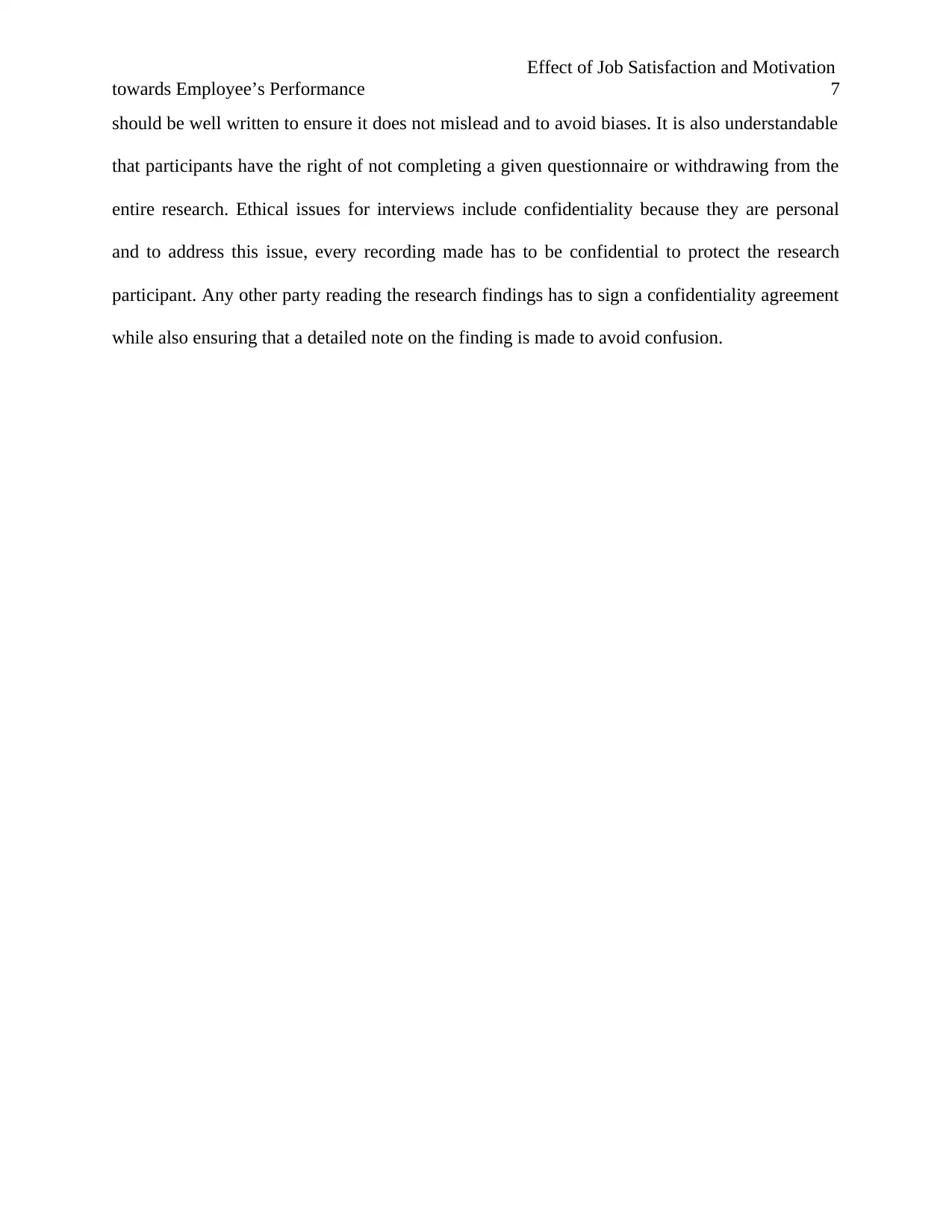
Effect of Job Satisfaction and Motivation
towards Employee’s Performance 7
should be well written to ensure it does not mislead and to avoid biases. It is also understandable
that participants have the right of not completing a given questionnaire or withdrawing from the
entire research. Ethical issues for interviews include confidentiality because they are personal
and to address this issue, every recording made has to be confidential to protect the research
participant. Any other party reading the research findings has to sign a confidentiality agreement
while also ensuring that a detailed note on the finding is made to avoid confusion.
towards Employee’s Performance 7
should be well written to ensure it does not mislead and to avoid biases. It is also understandable
that participants have the right of not completing a given questionnaire or withdrawing from the
entire research. Ethical issues for interviews include confidentiality because they are personal
and to address this issue, every recording made has to be confidential to protect the research
participant. Any other party reading the research findings has to sign a confidentiality agreement
while also ensuring that a detailed note on the finding is made to avoid confusion.
Paraphrase This Document
Need a fresh take? Get an instant paraphrase of this document with our AI Paraphraser
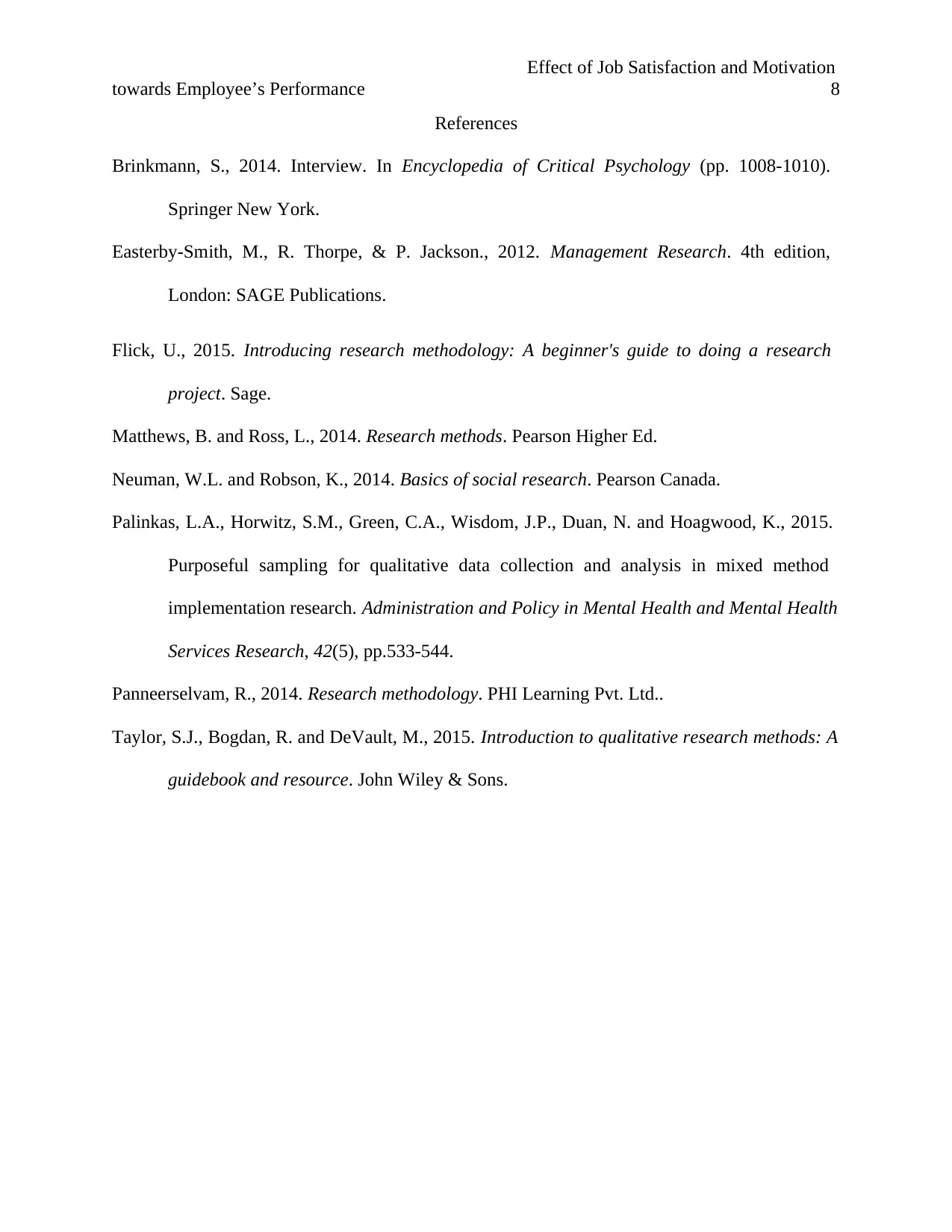
Effect of Job Satisfaction and Motivation
towards Employee’s Performance 8
References
Brinkmann, S., 2014. Interview. In Encyclopedia of Critical Psychology (pp. 1008-1010).
Springer New York.
Easterby-Smith, M., R. Thorpe, & P. Jackson., 2012. Management Research. 4th edition,
London: SAGE Publications.
Flick, U., 2015. Introducing research methodology: A beginner's guide to doing a research
project. Sage.
Matthews, B. and Ross, L., 2014. Research methods. Pearson Higher Ed.
Neuman, W.L. and Robson, K., 2014. Basics of social research. Pearson Canada.
Palinkas, L.A., Horwitz, S.M., Green, C.A., Wisdom, J.P., Duan, N. and Hoagwood, K., 2015.
Purposeful sampling for qualitative data collection and analysis in mixed method
implementation research. Administration and Policy in Mental Health and Mental Health
Services Research, 42(5), pp.533-544.
Panneerselvam, R., 2014. Research methodology. PHI Learning Pvt. Ltd..
Taylor, S.J., Bogdan, R. and DeVault, M., 2015. Introduction to qualitative research methods: A
guidebook and resource. John Wiley & Sons.
towards Employee’s Performance 8
References
Brinkmann, S., 2014. Interview. In Encyclopedia of Critical Psychology (pp. 1008-1010).
Springer New York.
Easterby-Smith, M., R. Thorpe, & P. Jackson., 2012. Management Research. 4th edition,
London: SAGE Publications.
Flick, U., 2015. Introducing research methodology: A beginner's guide to doing a research
project. Sage.
Matthews, B. and Ross, L., 2014. Research methods. Pearson Higher Ed.
Neuman, W.L. and Robson, K., 2014. Basics of social research. Pearson Canada.
Palinkas, L.A., Horwitz, S.M., Green, C.A., Wisdom, J.P., Duan, N. and Hoagwood, K., 2015.
Purposeful sampling for qualitative data collection and analysis in mixed method
implementation research. Administration and Policy in Mental Health and Mental Health
Services Research, 42(5), pp.533-544.
Panneerselvam, R., 2014. Research methodology. PHI Learning Pvt. Ltd..
Taylor, S.J., Bogdan, R. and DeVault, M., 2015. Introduction to qualitative research methods: A
guidebook and resource. John Wiley & Sons.
1 out of 8
Related Documents
Your All-in-One AI-Powered Toolkit for Academic Success.
+13062052269
info@desklib.com
Available 24*7 on WhatsApp / Email
![[object Object]](/_next/static/media/star-bottom.7253800d.svg)
Unlock your academic potential
Copyright © 2020–2025 A2Z Services. All Rights Reserved. Developed and managed by ZUCOL.





